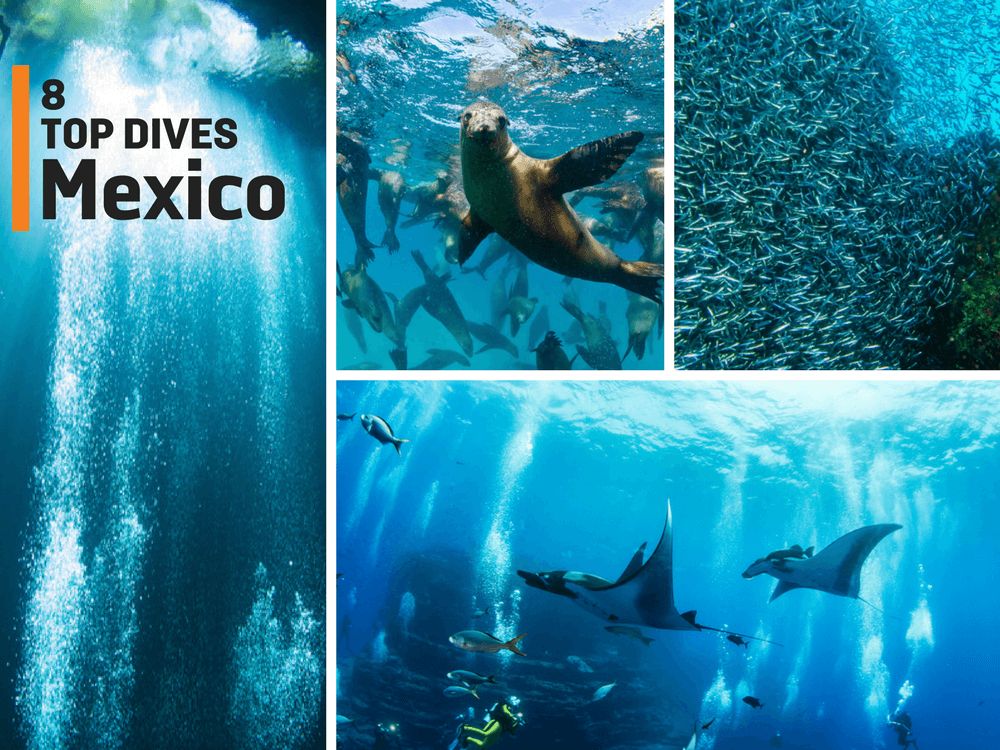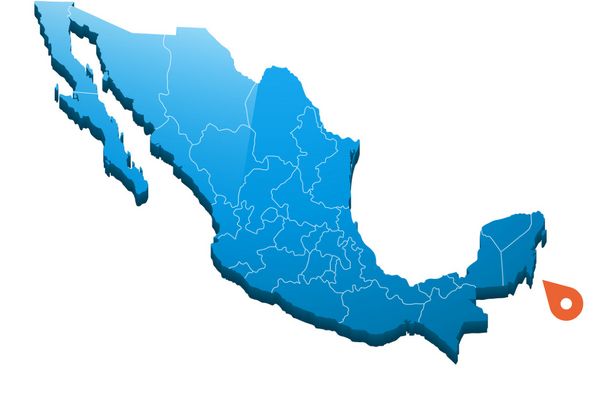
The diving in Mexico is rich and diverse – from dramatic pinnacles surrounded by large pelagics in the Revillagigedos to gentle drifts dives over the coral gardens of Cozumel; from cage diving with great white sharks to exploring mysterious and beautiful freshwater caves hidden in dense jungle. Here’s our choice from eight of the best places to scuba dive in Mexico
1) COZUMEL

Type: Reef • Suggested level: Beginner to intermediate • Watch out for: Splendid toadfish & large schools of various reef fish
This small island off the mainland peninsula of Yucatán in southeast Mexico is one of the globe’s most popular diving destination but, with more than 25 first class dive sites mostly in a marine park on its western side, it easily absorbs the crowds. Great walls, attractive swim-throughs and plenty of fish.

2) ISLA HOLBOX

Type: Snorkelling • Suggested level: All • Watch out for: Whale sharks & sailfish
From June to September large numbers of whale sharks gather to feed in sometimes groups of more than 100 individuals. The spectacle is now fairly well regulated with hundred of boats servicing a booming business. The outer areas provide the best experience as the waters are blue with good viz and the sharks are feeding on fish eggs rather than phytoplankton. These are the largest known aggregations of the ocean’s largest fish. From December to June you can also get in the water with sailfish feasting on small fish. From the largest to the fastest!

3) BANCO CHINCHORRO

Type: Reef • Suggested level: Intermediate • Watch out for: American crocodiles
This little known and hard to access diving area is, in fact, the largest coral atoll in the northern hemisphere. The atoll sits about 36 nautical miles offshore meaning a 90-minute boat trip from the small fishing town of Xcalak – but it is worth the effort. It has been a marine reserve since 1996 and is home to a large population of American crocodiles, plenty of fish and a good scattering of wrecks.
4) CABO PULMO

Type: Reef • Suggested level: Beginner to intermediate • Watch out for: Fish and more fish
Cabo Pulmo National Marine Park could well be the most successful marine reserve in the world – more than 20 years ago local conservationists and fishers started to campaign to protects the areas reefs at the southernmost tip of Baja California. A survey in 2011 revealed that in 10 years fish biomass had increased by 463 per cent and had helped reinvigorate marine life in the whole region. In 2005 Cabo Pulmo was named a UNESCO World Heritage Site, and in 2008 it became a Ramsar International Wetlands site
5) ESPIRITO SANTO

Type: Reef • Suggested level: Beginner • Watch out for: Californian sea lions
Just north of the island of Espirito Santo, are two large rock islets, one of which is a natural arch, where you can see reef fish including angelfish, surgeonfish and parrotfish amid orange cup corals. With a depth of 8m, it’s a great site for novices. Without a doubt, the main attraction though is the population of California sea lions. A colony of more than 200 of these playful pinnipeds lives on the islets and there is plenty of opportunity for underwater encounters with these remarkable creatures.
6) REVILLAGIGEDO ISLANDS

Type: Seamount, drift, liveaboard • Suggested level: Advanced • Watch out for: The big stuff
This is the place for high-energy, adrenaline diving. Exciting, demanding and, for the experienced diver, very rewarding. There are few other destinations in the world you can encounter such an impressive array of big beasts – humpback whales, giant manta rays, hammerhead shark.

7) GUADALUPE ISLAND

Type: Cage diving, liveaboard • Suggested level: Beginner to intermediate • Watch out for: Great white sharks
This is one of the best places in the world to see great white sharks – its relative isolation limits the boats to liveaboards (it is an 18-hour crossing from Ensenada) and the clear, blue water can result in visibility of nearly 50m (150ft). The sharks tend to start arriving around July and are gone by the end of November. Rowdy gangs of males arrive in July and August. The larger females start showing up in October and November. Most trips are for five days with three full days in the water with the sharks. In the peak months, it is possible that you will encounter as many as ten sharks on each dive. More than 200 individual animals have been identified in the area – if you strike really lucky and encounter a great white that has yet to be identified you get naming rights!

8) CENOTES

Type: Cavern • Suggested level: All • Watch out for: Haloclines
Dotted across the hot and dense jungle of the Yucatán peninsula are a number of sink wells – cenotes – which give you access to the most complex and longest system of underwater caves on earth. Entry level divers can be taken on safe guided tours and experienced cave divers can push to the extreme limits of diving. A stunning and unmissable experience.



